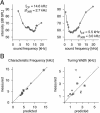Disentangling sub-millisecond processes within an auditory transduction chain
- PMID: 15660161
- PMCID: PMC539322
- DOI: 10.1371/journal.pbio.0030008
Disentangling sub-millisecond processes within an auditory transduction chain
Abstract
Every sensation begins with the conversion of a sensory stimulus into the response of a receptor neuron. Typically, this involves a sequence of multiple biophysical processes that cannot all be monitored directly. In this work, we present an approach that is based on analyzing different stimuli that cause the same final output, here defined as the probability of the receptor neuron to fire a single action potential. Comparing such iso-response stimuli within the framework of nonlinear cascade models allows us to extract the characteristics of individual signal-processing steps with a temporal resolution much finer than the trial-to-trial variability of the measured output spike times. Applied to insect auditory receptor cells, the technique reveals the sub-millisecond dynamics of the eardrum vibration and of the electrical potential and yields a quantitative four-step cascade model. The model accounts for the tuning properties of this class of neurons and explains their high temporal resolution under natural stimulation. Owing to its simplicity and generality, the presented method is readily applicable to other nonlinear cascades and a large variety of signal-processing systems.
Figures







References
-
- Hudspeth AJ, Logothetis NK. Sensory systems. Curr Opin Neurobiol. 2000;10:631–641. - PubMed
-
- Schiolten P, Larsen ON, Michelsen A. Mechanical time resolution in some insect ears. J Comp Physiol. 1981;143:289–295.
-
- French AS. Transduction mechanisms of mechanosensilla. Annu Rev Entomol. 1988;33:39–58.
-
- Robert D, Göpfert MC. Novel schemes for hearing and orientation in insects. Curr Opin Neurobiol. 2002;12:715–720. - PubMed
Publication types
MeSH terms
LinkOut - more resources
Full Text Sources
Other Literature Sources

